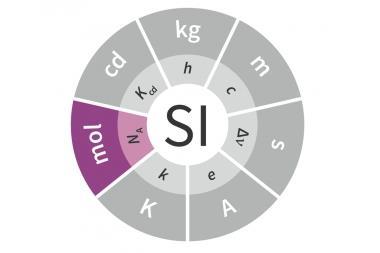Four of the base SI units, including the kilogram and mole, are set to be redefined
Four of seven base SI units - the kilogram, the mole, the ampere and the kelvin - are set to be redefined. Delegates at the 24th Conference on Weights and Measures, held in France on 21 October, were persuaded that the existing definitions of these units were outdated and needed to be dragged into the 21st century.
It was the definition of the kilogram, which has been controversial for decades, which prompted the changes. The original kilogram is defined by the international prototype, a cylinder of platinum-iridium that was cast in 1879. Over the years its mass has changed for reasons that are not entirely clear, but which may involve surface chemistry or the leaching of nitrogen or oxygen trapped during its manufacture.
For years the metrology community has disagreed about what form a new definition should take, but now the recommendations of the Consultative Committee for Units of the International Bureau of Weights and Measures have been accepted. The resolution to accept the new definitions represents something of a personal triumph for the committee's president, Ian Mills, emeritus professor of chemical spectroscopy at the University of Reading in the UK.
'There has been a good deal of argument about this and we have been working on it for some years,' Mills says. 'These things have to be agreed by everyone around the world.'
The committee recommended that the kilogram should be defined in relation to the Planck constant. 'We need a definition that is a true invariant,' Mills says. The new definition is: 'the kilogram is such that the Planck constant is exactly 6.6260693 x 10-34 joule-seconds'. The kilogram can be defined in terms of the Planck constant given that the unit of the Planck constant is equal to the unit of action – J s = kg m2 s-1 – and the second and metre have fixed numerical values in terms of the numerical values of the caesium hyperfine splitting frequency and the speed of light in a vacuum, respectively. So fixing the magnitude of the unit kg m2 s-1 has the effect of defining the kilogram.
At the same time as redefining the kilogram, the opportunity was taken to propose redefining three other base SI units 'to tidy up the system,' Mills says. The mole's current definition, based on the molar mass of carbon-12 being 12g per mole, has been changed to: 'the mole is such that the Avagadro constant is exactly 6.0221415 x 1023 per mole'. Mills says that the current definition is a bit obtuse. Changes were also proposed for the ampere and the kelvin.
The proposed definitions have yet to be ratified, which is expected to happen at a future General Conference of Weights and Measures. 'It will be some years before these proposals are adopted, but we have crossed the major hurdle,' Mills says. 'It was a bit touch and go, but we got there in the end.'
Mills stresses that the new definitions will not affect the everyday work of scientists. But he adds that 'defining base units to be used in all forms of fundamental science is very important for all sorts of reasons, for example in fundamental physics and in areas such as global positioning systems and other fields where timings, for example, are made to extremely precise limits.'
The definition of the remaining three base units, the second, the metre and the candela, will remain unchanged.











No comments yet